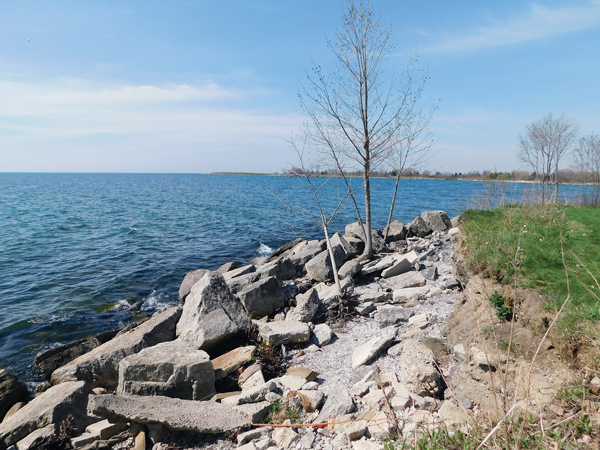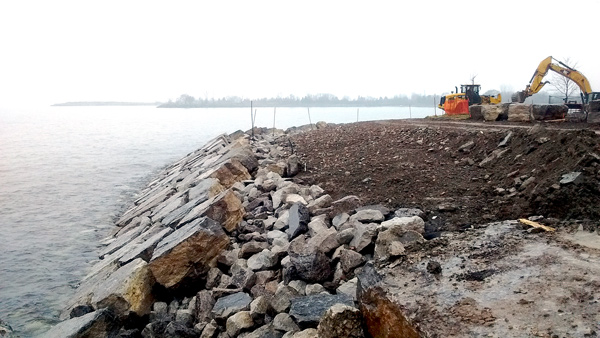By this summer, the Toronto Region and Conservation Authority (TRCA) will have completed the detailed and time-consuming erection of a new shoreline protection system at the Rotary Peace Park in southwest Toronto.
Consisting of 14,000 tonnes of armour stone revetment (each weighing between three to six tonnes) and 300- to 600-mm rip rap, the system will provide long-term erosion control from the pounding waves of adjacent Lake Ontario and protect park users from potential threats from that erosion.
Construction by TRCA’s crews began in August of last year and continued throughout the winter months. SEG Sarton Environmental Group was the equipment supplier/operator contractor.
Judged solely by the 144-metre (472 feet) and $1.4 million cost, the maintenance project might not seem overly complex.
But dismantling the failed half-century-old existing system and rebuilding the new one was a myriad of challenges, not the least of which was the sourcing and as-needed delivery of the armour stones from Ontario’s Kawartha district.
Acting as its own project and construction manager, the conservation authority had to choreograph the project so it would adhere to in-water construction regulations, take measures to minimize the impact on the rest of the park, and deal with the concerns of a private property owner.
Preceding the construction was an extensive planning and public consultation process and the update of an almost five-year-old design.
The original park was greatly enlarged by a 1960s landfill operation which created a U-shape easterly addition jutting out into the lake and this is where the new system is being put in place.
Classified as a “structure,” the original armour stone revetment had been monitored for erosion since 2006 and was deemed a high priority project in 2010.
Design work for its restoration was created by Shoreplan Engineering Ltd. in 2013, but the new shoreline protection had to be postponed because of funding constraints and other projects, says authority erosion risk management project manager Jet Taylor.
That changed in the spring of 2017 when record high lake levels further exacerbated the erosion problems and Rotary Peace Park was earmarked as “the number one priority” in the authority’s Western Waterfront Master Plan which it had started preparing the year before, he says.
(Some of the problems included the slumping of revetment and large rock material into the lake and the erosion of pathway presenting a safety risk.)
Shoreplan Engineering, the original consultants, was asked to make small revisions to the design and “just before construction started last year we took another hard look at it.”

In the lead-up to the construction, extensive preparatory work was undertaken including the erection of a 300-metre-long (984-foot) fence which cordoned off the construction zone from the rest of the park, allowing the public continued use of an outdoor swimming pool, a baseball diamond and other recreational amenities, plus access to a popular beach area on the west side of the park, says Taylor.
The authority had planned to incorporate as much as the original armour stone, gabion baskets and concrete rubble into the new wall as possible. But some of that material didn’t meet modern day specifications “so we had to haul away some material and add more.”
First and most complicated step in the construction/restoration sequence was the in-water installation of “toe stones” to prevent the armour stone revetment from sinking into the water.
No machinery was allowed to operate in the water and that meant the excavator operator “had to work in the blind” a few metres away on the shoreline to excavate trenches for the stones. And on rainy or windy days the excavation had to be halted to “limit the risk of stirring up sediment or possibly washing fluids from the machine into the water.”
A major goal was to build the structure in a series of complete sections — starting with toes stones and then the armour stone revetment — before moving on to the next section.
But that wasn’t always achievable. A combination of factors such as rain and heavy winds and the need to be out of the water during fish spawning months necessitated the consecutive installation of the toes stones in several areas and then completing the other phases later, says Taylor.
For the almost entire length, the armour stone was installed in a 2-to-1 slope. The one notable deviation from that geometric pattern was at the very eastern perimeter of the park where it abuts a private property. At that spot, the TRCA work crews erected a vertical wall at the request of a private property owner to deter trespassers and to stay on the park property.
Because of the need to protect fish habitat and other environmental constraints, in-water construction moves at slower pace than land construction and Rotary Peace Park was no exception. The progress of the work was also hampered by the fact that one of two excavators originally allocated for the project had to be transferred elsewhere.
“We thought we would be done by now,” Taylor says.
But the earthworks will be completed in May, with landscaping and park restoration carrying on into June. That final phase will include tree planting and the building of a drainage swale to allow water to percolate away slowly, he says.
The authority has identified another 20 waterfront erosion problem areas it would like to restore in the next 10 years, says Taylor.




Recent Comments
comments for this post are closed